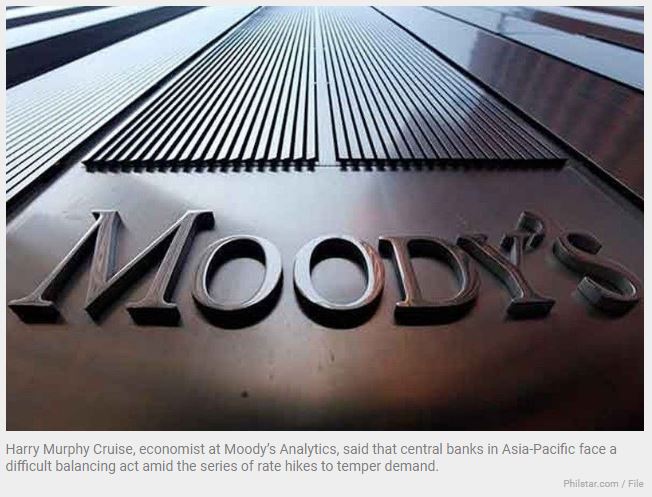Philippines – Moody’s Analytics: Tightening cycle helped temper inflation
MANILA, Philippines — The tightening cycle being undertaken by central banks in Asia-Pacific including the Bangko Sentral ng Pilipinas (BSP) has succeeded in slowing the rise in prices, according to Moody’s Analytics.
In a report, Harry Murphy Cruise, economist at Moody’s Analytics, said that central banks in Asia-Pacific face a difficult balancing act amid the series of rate hikes to temper demand.
Cruise said the Philippines, Indonesia and Thailand have hiked rates less than a handful of times as the region generally lagged behind the tightening cycle of the US Federal Reserve.
The BSP has so far raised interest rates by 175 basis points, including a huge 75-basis-point hike during a surprise off-cycle rate-setting meeting on July 14 to curb rising inflationary pressures.
This brought the benchmark policy rate to 3.75 percent from an all-time low of two percent. The tightening cycle has almost reversed the accommodative cycle wherein the central bank slashed interest rates by 200 basis points as part of its COVID response measures.
“The clearest measure of success for central banks will be how successful they are in slowing price rises. To date, the APAC region has seen some modest improvement. Inflation has moderated in South Korea, Taiwan, India, the Philippines and Vietnam,” Cruise said.
Inflation in the Philippines eased slightly to 6.3 percent in August from 6.4 percent in July due to lower oil and food prices.
However, the economist of the research arm of the Moody’s Group is not convinced that the rapidly rising inflation in Asia-Pacific would continue to ease in the coming months.
“The sustainability of this trend is unknown,” Cruise said.
On the other hand, price growth continues to trend higher in Australia, New Zealand, Singapore and Malaysia.
Inflation in the Philippines averaged 4.9 percent from January to August, well above the BSP’s target range of two to four percent.
This prompted the Monetary Board to raise its inflation forecast to 5.4 percent for this year.
With the series of rate hikes, the BSP now expects inflation to average four instead of 4.2 percent for 2023 and to 3.2 instead of 3.3 percent for 2024.
According to Cruise, supply snarls and rising domestic demand have pushed inflation to uncomfortable levels.
“That has seen borrowing costs rise sharply as central banks desperately try to rein in prices,” the economist said.
Moody’s Analytics said central banks are in a sticky situation as price increases caused by the impact of the Russia-Ukraine war and COVID lockdowns in China are largely driven by factors outside the control of policymakers.
“It’s a delicate balancing act. Hike too aggressively, and central banks could tip their economies into recession. But if they are too slow to act, inflation (and inflation expectations) could spiral. So, like a freshly poured pint, central bankers are trying to take froth off the top of the domestic economy without spilling a drop,” Cruise said.
Central banks in the region have raised interest rates to dampen household spending, take the heat out of the labor market, and prevent wages from rising too quickly in order to help inflation subside.
Source: https://www.philstar.com/business/2022/09/14/2209489/moodys-analytics-tightening-cycle-helped-temper-inflation


 Thailand
Thailand




